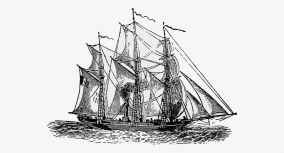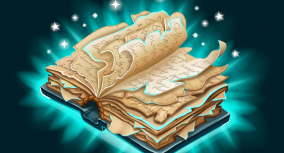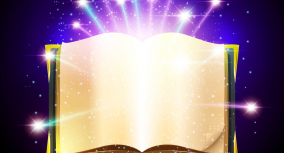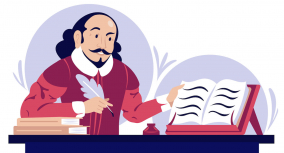Literary devices in The Tempest are critical to revealing the play’s deeper meanings and helping readers interpret its characters and plot. Shakespeare skillfully uses imagery, personification, symbolism, soliloquies, and other techniques to explore central themes like magic and power.
Whether you’re someone who loves digging into literary devices or a student who seeks help with the play’s analysis, this article by Custom-Writing.org experts is just what you need. Here, we discuss:
- The Tempest genre and how it blends comedy, romance, and fantasy
- The play’s setting—an isolated island filled with mystery, and its role in the plot
- Key symbols in The Tempest, such as Prospero’s books and the chess game
- The vivid imagery in The Tempest and more
📖 The Tempest Genre
The Tempest genre falls under two categories: comedy and romance. First of all, it is evident that there are some dreadful moments in the story, including two assassination attempts. There are also a storm and scary magic. Despite all that, no character dies in the play. In the end, everyone who was lost is reunited, every traitor is forgiven, no revenge is needed. Therefore, comedy is intact. Finally, it seems like every scene revolves around the relationship. Even the ship ended up in the sea because of marriage. Of course, the happiest event of the story is Miranda and Ferdinand’s newly created union of true love. What can be more romantic?
📍 The Tempest Setting
Even though the main action is taking place on a tiny remote island, it provides enough space and opportunities as The Tempest setting. It allowed Shakespeare to concentrate all the goodness of the play. Not only everything happens in one place, but also in a short time. Moreover, the island happens to be the magical place that allows Prospero to fulfill all his plans. All the illusions used there are aimed to manipulate the characters. The setting seems to be such an important place, but the exact location of the island in The Tempest remains unknown, which adds more mystery to its magical theme.
🦄 Symbols in The Tempest
There are some ideas that the authors present to the readers through signs and objects, which are called symbols. Shakespeare introduced a few symbols in The Tempest that are worth our attention. One of the most significant ones appears to be Prospero’s books, which he uses constantly. Another such sign is the game of chess.

Prospero’s Books
From the beginning of the story, we already get to understand that Prospero’s books are precious to him. Gonzalo knew about it, so he put them in the boat when the former duke and his daughter were running. Therefore, the audience can find out that Prospero can possess and use his magic power only thanks to the books.
At the same time, there is another meaning of this symbol that may help us understand Prospero’s character better. He was so consumed by the process of studying in his library that he lost cautiousness which allowed his brother to take over. It shows how much Prospero desires to be alienated and away from the rest of the world. This obsession with books and magic even made him believe that raising Miranda in isolation would be the best choice.
Knowing I loved my books, he furnish’d me
The Tempest, Prospero, Act I, Scene II
From mine own library with volumes that
I prize above my dukedom.
At the end of the story, the main hero claims that he uses magic the last time by promising to throw away the books. By that, we also understand that he is finally ready to leave the burden of his obsession and return to the world. On the other hand, such a symbol might represent Shakespeare’s ideas and words. We can hear him desiring to retire in Prospero’s final speech and will give up his books.
Chess in The Tempest
Another crucial symbol in The Tempest is the game of chess. Prospero reveals Ferdinand and Miranda playing chess at the end of the story.
Yes, for a score of kingdoms you should wrangle,
The Tempest, Miranda, Act V, Scene I
And I would call it, fair play.
It might then be suggested that it reflects how Prospero has been using every character as pieces to achieve his primary goal. Surprisingly, the main object of the game is to capture the king, which matches Prospero’s plans. Through multiple manipulations, he achieves this goal and catches Alonso, who has no other choice but to accept all the conditions. Ferdinand and Miranda’s marriage appears to be of a political factor as well. Therefore, Prospero is shown as a skillful chess player by thinking through every step, beginning with the shipwreck.
Moreover, Ferdinand and Miranda happen to be the main pieces Prospero uses in this plan. His power over the characters is so great that they don’t even realize they are manipulated. When the newlyweds are revealed in the last scene playing, they can’t help but keep being involved in chess for a little while. Miranda and Ferdinand are talking about love and other gentle feelings to each other and seem to be so remote from the rest of the world. The staging of this scene looks almost perfect. Prospero promised to quit his magic, and yet, it appears that his daughter is still his pawn.
If you’re looking for inspiration or more information on symbols in literature, check our articles on nature and color symbolism!
🏺 The Tempest Background
The historical analysis of The Tempest might point out a few interesting things as well. Most likely, the play was written around 1611 and first presented on the stage at Court the same year. Moreover, it was probably one of the last plays that Shakespeare wrote. What makes it more remarkable is that it is one of the two plays with completely fresh plots.
Shakespeare went on to highlight the historical context in The Tempest. At the time, a few incidents happened near the Bermudas, which can be correlated to a shipwreck theme. Besides, one of the most discussed topics of colonization is also brought up in the play. Almost every character has wondered at least once how they would rule the island they have just arrived at. Another exciting observation goes back to this literary theme. One of Montaigne’s essays translated in 1603 mentions cannibals, which could have served as an inspiration for Shakespeare. Caliban’s name strangely resembles the sound of the word “cannibal.”
When Was The Tempest Written?
It is believed that The Tempest was written around 1610-1611. One of the last Shakespeare’s plays was then performed to celebrate King James‘ daughter’s marriage. It can be considered quite relative at the time since it highlights the ideas of boat journeys and colonization, which were such a popular topic.
⚙️ Literary Devices in The Tempest
Some of the most famous literary devices in The Tempest are, of course, imagery and personification. Prospero seems to use it more than others. He often refers to abstract things, such as time and destiny, as to human ones. At the same time, it highlights their importance. The imagery was essential at first when the play just came out since the stage sets and costumes were far from impressive. They weren’t enough to bring the whole picture into life, so the audience had to rely on Shakespeare’s imagery.
However, one technique should be discussed separately. Shakespeare appears to favor using soliloquies since they come up so often in his other works. It allows the audience to have an even deeper understanding of the character. The trick only works when the character is alone on the stage and reveals the deepest thoughts thinking no one hears them. Shakespeare doesn’t use too many soliloquies in The Tempest since the dramatic moments are not too intense.
There is another interesting device that the author involves in the play. It is called the aside. The character addresses the audience and reveals some juicy details, while the rest of the characters are not aware of it and can’t hear those words. Once again, it is a great assistance in understanding the plot.
Thank you for reading this article! If you need help with formulating a thesis for The Tempest analysis paper, try our thesis statement generator. If you are looking for an essay idea on the play, you might want to take a look at The Tempest essay topics collection. Any questions left? Check The Tempest QA section!
🔗 References
- Language, Imagery & Themes in The Tempest
- The Tempest: Entire Play – Shakespeare (MIT)
- A Glimpse at Symbolism Used in Shakespeare’s The Tempest
- What is the message of The Tempest? – Quora
- A Short Guide to Imagery, Symbolism, and Figurative Language: Austin Community College
- On the Social Function of Theatre in “The Tempest” – jstor

































